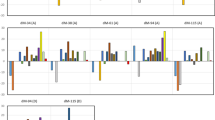Abstract
The role of the acid–base equilibria and the sequential proton loss electron transfer mechanism (SPLET) on the free radical scavenging activity of six melatonin-related compounds was investigated using the density functional theory. It was found that this chemical route is particularly important for about half of the studied compounds. Some of their pKa values are reported here for the first time. In addition, our results also indicate that anionic species, presenting the phenolate moiety, may be crucial to scavenge peroxyl radicals albeit their populations are relatively low at physiological pH. The key number to consider in this context should be the product of the molar fraction of the reacting compound, at the pH of interest, by the corresponding rate constant.


Similar content being viewed by others
References
Reiter RJ, Paredes SD, Manchester LC, Tan DX (2009) Crit Rev Biochem Mol Biol 44:175
Aversa S, Pellegrino S, Barberi I, Reiter RJ, Gitto E (2012) J Matern Fetal Neonatal Med 25:207
Manchester LC, Coto-Montes A, Boga JA, Andersen LPH, Zhou Z, Galano A, et al. (2015) J Pineal Res 59:403–419
Tan DX, Manchester LC, Reiter RJ, Qi WB, Karbownik M, Calvo JR (2000) Biol Signals Recept 9:137
Reiter RJ, Tan DX, Galano A (2014) Physiology 29:325
Zhang HM, Zhang Y (2014) J Pineal Res 57:131
Alvarez-Diduk R, Galano A, Tan DX, Reiter RJ (2015) J Phys Chem B 119:8535
Litwinienko G, Ingold KU (2003) J Org Chem 68:3433
Litwinienko G, Ingold KU (2004) J Org Chem 69:5888
Litwinienko G, Ingold KU (2005) J Org Chem 70:8982
Litwinienko G, Ingold KU (2007) Acc Chem Res 40:222
Foti MC (2007) J Pharm Pharmacol 59:1673
Medina ME, Galano A, Alvarez-Idaboy JR (2014) Phys Chem Chem Phys 16:1197
Cordova-Gomez M, Galano A, Alvarez-Idaboy JR (2013) RSC Adv 3:20209
Iuga C, Alvarez-Idaboy JR, Russo N (2012) J Org Chem 77:3868
Benayahoum A, Amira-Guebailia H, Houache O (2014) Comput Theor Chem 1037:1
Marković Z, Crossed D, Signorović J, Dimitrić Marković JM, Živić M, Amić D (2014) Monatsh Chem 145:953
Pérez-González A, Galano A, Alvarez-Idaboy JR (2014) New J Chem 38:2639
Martínez A, Hernández-Marin E, Galano A (2012) Food Funct 3:442
Xue Y, Zhang L, Li Y, Yu D, Zheng Y, An L et al (2013) J Phys Org Chem 26:240
Mendoza-Wilson AM, Castro-Arredondo SI, Balandrán-Quintana RR (2014) Food Chem 161:155
Dimitrić Marković JM, Milenković D, Amić D, Popović-Bijelić A, Mojović M, Pašti IA et al (2014) Struct Chem 25:1795
Dorović J, Marković JMD, Stepanić V, Begović N, Amić D, Marković Z (2014) J Mol Model 20:Art Id 2345
Lengyel J, Rimarčík J, Vagánek A, Klein E (2013) PCCP 15:10895
Medina ME, Iuga C, Álvarez-Idaboy JR (2014) RSC Adv 4:52920
Caicedo C, Iuga C, Castañeda-Arriaga R, Alvarez-Idaboy JR (2014) RSC Adv 4:38918
Wright JS, Johnson ER, DiLabio GA (2001) J Am Chem Soc 123:1173
Foti MC, Daquino C, Mackie ID, DiLabio GA, Ingold KU (2008) J Org Chem 73:9270
Zhao Y, Schultz NE, Truhlar DG (2006) J Chem Theory Comput 2:364
Marenich AV, Cramer CJ, Truhlar DG (2009) J Phys Chem B 113:6378
Velez E, Quijano J, Notario R, Pabón E, Murillo J, Leal J et al (2009) J Phys Org Chem 22:971
Black G, Simmie JM (2010) J Comput Chem 31:1236
Furuncuoǧlu T, Uǧur I, Degirmenci I, Aviyente V (2010) Macromolecules 43:1823
Zhao Y, Truhlar DG (2008) J Phys Chem A 112:1095
Frisch MJ, Trucks GW, Schlegel HB, Scuseria GE, Robb MA, Cheeseman JR et al (2009) Gaussian 09. Gaussian, Inc., Wallingford
Eyring H (1935) J Chem Phys 3:63
Evans MG, Polanyi M (1935) Trans Faraday Soc 31:875
Truhlar DG, Garrett BC, Klippenstein SJ (1996) J Phys Chem 100:12771
Marcus RA (1993) Rev Modern Phys 65:599
Marcus RA (1997) Pure Appl Chem 69:13
Collins FC, Kimball GE (1949) J Colloid Sci 4:425
Smoluchowski M (1917) Z Phys Chem 92:129–168
Einstein A (1905) Ann Phys 17:549
Stokes GG (1903) Mathematical and physical papers. Cambridge University Press, Cambridge
Galano A, Alvarez-Idaboy JR (2013) J Comput Chem 34:2430
Ho J, Coote ML (2010) Theor Chem Acc 125:3
Mahal HS, Sharma HS, Mukherjee T (1999) Free Radic Biol Med 26:557
Weber OA, Simeon V (1971) J Inorg Nucl Chem 33:2097
Rudnick G, Kirk KL, Fishkes H, Schuldiner S (1989) J Biol Chem 264:14865
Chattopadhyay A, Rukmini R, Mukherjee S (1996) Biophys J 71:1952
Corona-Avendao S, Romero-Romo MA, Rojas-Hernández A, Ramírez-Silva MT (2005) Spectrochim Acta Pt A Mol Spectrosc 61:621
Galano A, Tan DX, Reiter RJ (2013) J Pineal Res 54:245
Acknowledgments
We gratefully acknowledge the Laboratorio de Visualización y Cómputo Paralelo at Universidad Autónoma Metropolitana-Iztapalapa for computing time. This work was partially supported by project SEP-CONACyT 167491. R. A.-D. acknowledges the economic support provided by the same project during his postdoctoral scholarship.
Author information
Authors and Affiliations
Corresponding author
Additional information
Published as part of the special collection of articles “CHITEL 2015 - Torino - Italy”.
Electronic supplementary material
Below is the link to the electronic supplementary material.
Rights and permissions
About this article
Cite this article
Álvarez-Diduk, R., Galano, A., Tan, D.X. et al. The key role of the sequential proton loss electron transfer mechanism on the free radical scavenging activity of some melatonin-related compounds. Theor Chem Acc 135, 38 (2016). https://doi.org/10.1007/s00214-015-1785-5
Received:
Accepted:
Published:
DOI: https://doi.org/10.1007/s00214-015-1785-5




